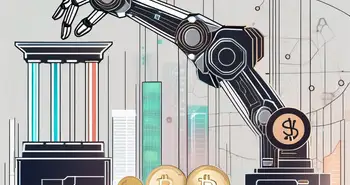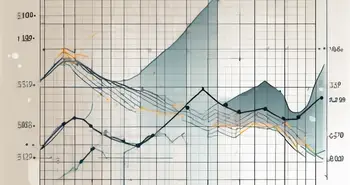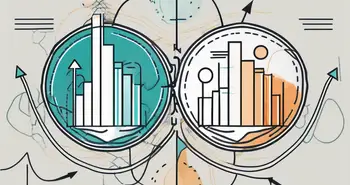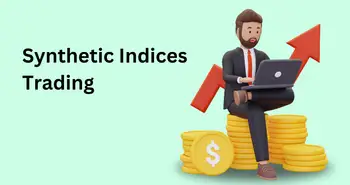The Definitive Guide to Automated Market Making: Strategies, Algorithms, and Future Trends

Automated Market Making (AMM) has revolutionized the world of crypto trading, providing liquidity and order execution like never before. As an expert in the field, I am here to guide you through the intricacies of AMM, explaining its definition, function, mechanics, benefits, risks, and future trends.
Understanding Automated Market Making
Definition and Function of Automated Market Making
Automated Market Making refers to the process of using algorithmic trading bots to facilitate liquidity provision in financial markets. These bots, known as Automated Market Makers (AMMs), continuously quote bid and ask prices for a particular trading pair, aiming to match traders who wish to buy and sell assets.
AMMs rely on smart contracts and complex mathematical formulas to automatically set prices based on supply and demand dynamics. By doing so, they eliminate the need for traditional order books and provide efficient and decentralized trading experiences.
Automated Market Makers have revolutionized the way trading is conducted in various markets, offering increased efficiency and accessibility. The algorithms used by AMMs are designed to react quickly to market changes, ensuring that prices remain competitive and trades are executed promptly. This automation not only streamlines the trading process but also reduces the impact of human emotions on decision-making, leading to more rational and consistent outcomes.
The Role of Automated Market Makers in Crypto Trading
In the rapidly evolving world of cryptocurrency trading, AMMs play a crucial role in ensuring smooth market operations. They enable investors to trade assets instantly, without facing the limitations of traditional order book models.
Moreover, AMMs facilitate the listing of new tokens by allowing liquidity to be created from the start, preventing issues such as low trading volumes or price manipulation. This has significantly contributed to the growth and development of the decentralized finance (DeFi) ecosystem.
The transparency and accessibility offered by AMMs have attracted a wide range of participants to the crypto market, including retail traders and institutional investors. This increased participation has led to greater market liquidity and price stability, making cryptocurrencies a more viable asset class for investment and trading.
The Mechanics of Automated Market Making
How Automated Market Making Works
At the heart of AMM is a sophisticated mathematical model known as Constant Product Market Maker (CPMM). This model ensures the continuous availability of liquidity by maintaining a constant product of token balances.
When a trader places a buy or sell order, the AMM algorithm adjusts the token prices based on the imbalance between the assets. The goal is to incentivize traders to provide liquidity and restore equilibrium.
To make this happen, AMMs rely on a concept called an Automated Price Curve, which defines the relationship between token prices and balances. This curve allows AMMs to adjust prices dynamically, ensuring efficient trading even in volatile markets.
Key Components of Automated Market Making
While the precise implementation can vary, automated market making systems typically consist of three main components:
- Liquidity Pools: These pools hold assets contributed by liquidity providers and are used to execute trades. Liquidity providers earn fees based on the volume of trades and their proportional contributions.
- Smart Contracts: These self-executing contracts enforce the rules, conditions, and obligations of AMM transactions. They ensure transparency, security, and trust between market participants.
- Oracles: These external data sources provide real-time information to the AMMs, helping them accurately estimate asset prices and adjust trading parameters accordingly.
Let's dive deeper into each of these components to gain a better understanding of how they contribute to the mechanics of automated market making.
Liquidity Pools: The Lifeblood of Automated Market Making
Liquidity pools play a crucial role in ensuring the smooth operation of automated market making systems. These pools act as reservoirs of assets that are contributed by liquidity providers. When a trader wants to execute a trade, they interact with these pools, which hold the necessary tokens for the transaction.
By contributing assets to the liquidity pools, liquidity providers enable traders to buy or sell tokens without relying on traditional order books. This decentralized approach eliminates the need for a centralized exchange and allows for continuous trading, even during times of high volatility.
As compensation for their contribution, liquidity providers earn fees based on the volume of trades and their proportional contributions to the pool. This incentivizes them to provide liquidity and ensures the availability of assets for trading.
Smart Contracts: Building Trust and Transparency
Smart contracts are the backbone of automated market making systems, providing the necessary infrastructure to execute transactions in a trustless and transparent manner. These self-executing contracts are programmed with predefined rules, conditions, and obligations that govern the behavior of market participants.
By leveraging blockchain technology, smart contracts ensure that all transactions are executed as intended, without the need for intermediaries. This eliminates the risk of manipulation or fraud, as the rules are enforced automatically and cannot be tampered with.
Furthermore, smart contracts enable transparency by making all transaction data publicly available on the blockchain. This allows market participants to verify the integrity of the system and builds trust among traders, liquidity providers, and other stakeholders.
Oracles: The Eyes and Ears of Automated Market Making
Oracles serve as the eyes and ears of automated market making systems, providing real-time data that is crucial for accurate price estimation and trading parameter adjustments. These external data sources feed information to the AMMs, enabling them to make informed decisions based on the current market conditions.
For example, oracles can provide data on the prices of different assets, trading volumes, or even external events that may impact the market. This information is then used by the AMM algorithm to adjust token prices and maintain equilibrium.
By relying on oracles, automated market making systems can adapt to changing market dynamics and ensure efficient trading even in the face of unpredictable events. The accuracy and reliability of the oracles are of utmost importance, as any inaccuracies or delays in data can have significant implications for the performance of the AMM.
By understanding the intricacies of liquidity pools, smart contracts, and oracles, we can appreciate the robustness and sophistication of automated market making systems. These components work in harmony to provide continuous liquidity, enforce trust and transparency, and adapt to market conditions, ultimately revolutionizing the way we trade and exchange assets.
Benefits of Automated Market Making
Efficiency and Speed
One of the primary benefits of AMM is its high efficiency and speed in executing trades. Unlike traditional order books, which require matching orders from multiple participants, AMMs provide instant liquidity, allowing traders to buy or sell assets at any time.
AMMs also eliminate the need for intermediaries, enabling direct peer-to-peer transactions without relying on centralized exchanges. This leads to faster settlement times and lower transaction costs, benefiting both traders and liquidity providers.
Reducing Market Volatility
AMMs' continuous liquidity provision helps reduce market volatility by stabilizing prices. When demand outstrips supply for a particular asset, the AMM algorithm automatically adjusts prices, discouraging extreme price swings.
This aspect of AMM has been crucial in overcoming liquidity challenges in decentralized exchanges, as it ensures that even relatively illiquid tokens have enough liquidity to trade effectively.
Risks and Challenges in Automated Market Making
Potential Risks of Automated Market Making
While AMMs offer several advantages, it is important to acknowledge the potential risks associated with this technology. One key risk is impermanent loss, which occurs when the value of assets in a liquidity pool changes compared to holding them individually.
Another risk is the vulnerability to external market manipulation. As AMMs rely on publicly available prices, they can be influenced by sudden market shifts or liquidity attacks. However, advancements in security protocols and oracle technologies are constantly addressing these concerns.
Overcoming Challenges in Automated Market Making
To mitigate risks and challenges related to AMMs, it is essential to implement robust risk management measures and regularly update market-making strategies. Additionally, ongoing research and development in the field are crucial to enhancing the security and efficiency of AMM protocols.
Future of Automated Market Making
Technological Advancements and Their Impact
The future of automated market making looks promising, with ongoing technological advancements set to enhance the capabilities and efficiency of AMMs. Smart contract platforms are evolving, allowing for increased customization and integration with other DeFi protocols.
Furthermore, the integration of machine learning and artificial intelligence into AMM models has the potential to revolutionize market making strategies. These advancements can provide even greater liquidity and tailored trading experiences, ensuring both traders and liquidity providers benefit from the evolving landscape of AMMs.
Predicted Trends in Automated Market Making
As the cryptocurrency market continues to grow, AMMs are expected to become an integral part of the global financial ecosystem. Increased adoption and regulatory clarity will bring more institutional players into the space, further boosting liquidity and market efficiency.
Moreover, the future of AMMs will witness exciting developments in cross-chain compatibility, enabling trading across multiple blockchain networks. This interoperability will unlock new trading opportunities and foster a more connected and efficient decentralized financial ecosystem.
As an expert in the field of automated market making, I personally encourage traders and liquidity providers to embrace and explore the immense potential offered by AMMs. By tapping into the benefits of AMM protocols, such as increased liquidity, efficiency, and reduced market volatility, you can navigate the crypto markets with greater confidence and success.
FAQ – Frequently Asked Questions
What is Automated Market Making?
Automated Market Making refers to the process of using algorithmic trading bots to facilitate liquidity provision in financial markets. These bots continuously provide bid and ask prices for a particular trading pair, allowing traders to buy and sell assets instantly.
How do Automated Market Makers work?
Automated Market Makers rely on complex mathematical formulas and smart contracts to automatically adjust prices based on supply and demand dynamics. This ensures continuous availability of liquidity and prevents the need for traditional order books.
What are the benefits of Automated Market Making?
Automated Market Making offers high efficiency, speed, and reduced market volatility. Traders can execute trades instantly, without relying on centralized exchanges. Furthermore, AMMs stabilize prices by adjusting them in response to imbalances between supply and demand.
What are the risks associated with Automated Market Making?
Potential risks include impermanent loss and vulnerability to external market manipulation. Impermanent loss refers to the difference in value between holding assets individually and participating in a liquidity pool. However, ongoing advancements in security protocols are mitigating these risks.
What does the future hold for Automated Market Making?
The future of AMMs looks promising, with ongoing technological advancements and increased adoption by institutional players. The integration of machine learning and the development of cross-chain compatibility are expected to further enhance the capabilities and efficiency of AMM protocols.
Now armed with the knowledge and understanding of automated market making, you can confidently navigate the world of crypto trading and leverage the advantages offered by AMMs.
Ready to take your trading to the next level with the insights from Automated Market Making? Join Morpher, the revolutionary trading platform that's changing the game with blockchain technology. Experience zero fees, infinite liquidity, and the freedom to trade across multiple asset classes – all on a user-centric platform that puts you in control. With Morpher, you can start investing with as little as $1, benefit from short selling without interest fees, and even leverage your trades up to 10x. Embrace the future of investing with a unique trading experience that's tailored for the modern trader. Sign Up and Get Your Free Sign Up Bonus today, and be part of the global community that's democratizing trading with Morpher.

Disclaimer: All investments involve risk, and the past performance of a security, industry, sector, market, financial product, trading strategy, or individual’s trading does not guarantee future results or returns. Investors are fully responsible for any investment decisions they make. Such decisions should be based solely on an evaluation of their financial circumstances, investment objectives, risk tolerance, and liquidity needs. This post does not constitute investment advice.

Painless trading for everyone
Hundreds of markets all in one place - Apple, Bitcoin, Gold, Watches, NFTs, Sneakers and so much more.

Painless trading for everyone
Hundreds of markets all in one place - Apple, Bitcoin, Gold, Watches, NFTs, Sneakers and so much more.









